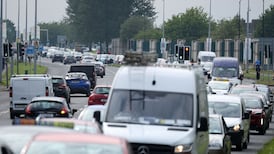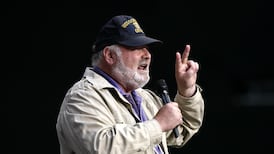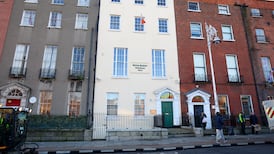There are several striking, if not surprising, things about this year's Leaving Certificate statistics. Most notably, the numbers doing higher-level mathematics, physics and chemistry, the subjects the experts stress are increasingly necessary in this scientific and technological age, are down.
Those taking higher-level maths are down 2.9 per cent on last year, which saw an increase of 16.6 per cent over 1996, a figure distorted by the numbers doing Transition Year, and 10 per cent over 1995.
But there was also a significant increase in good results in higher-level maths. The numbers getting A and B grades rose from 45.2 per cent last year to 54.1 per cent this year; those getting A, B and C grades went from 76.8 per cent in 1997 to 83.7 per cent this year.
At the other end of the scale 14.3 per cent failed ordinary-level maths, an increase of 1.8 per cent on last year.
The principal of Maynooth Post Primary School, Mr Sean Ashe, said the numbers taking higher-level maths should be seen in the context of the National Council for Curriculum and Assessment maths course committee's projections for the subject.
In the early 1990s it had projected 12,000 doing higher-level mathematics. The number taking the subject this year, although it had dipped slightly, was just over 10,700, more than double the figure in the early 1990s. But Mr Ashe said he would not want to see the small decline in numbers continuing.
Regarding the more than 14 per cent of students who had gained grade A in ordinary-level maths, he wondered whether more ordinary-level students, perhaps up to 1,000, should be doing it at higher level.
Mr Ashe was not surprised at the good results at the top end of higher-level maths: "It's what you'd expect from the calibre of students we get, particularly since this year's paper was a fair one and last year's was difficult."
He expressed concern at the high failure rate at ordinary level, where he said there had been a "very testing paper" this year.
Mr Gerard O'Donoghue, a chemistry teacher at St Clement's College, Limerick, was very disappointed at the ordinary-level chemistry results. There was a 16.6 per cent decline in the number getting A and B grades, and a 17.2 per cent decline in those getting A, B and C.
There was a big increase in D grades, from 24.1 per cent last year to 31.7 per cent this year. Some 52 per cent of students had received D or less, and 21.5 per cent had failed ordinary level. Nearly 10 per cent more had failed higher-level chemistry.
With the numbers doing chemistry continuing to fall, such results would not encourage students to take up the subject, Mr O'Donoghue said. At present ordinary-level chemistry was just a "scaled-down version" of the higher-level course.
Another problem was the transition from the Junior Certificate course, which was based on memorising facts, to the Leaving Certificate course, which required "a high degree of comprehension and mathematical aptitude. Those who do better at chemistry also have good maths skills and comprehension".
In Irish, the results were generally slightly better than last year, although the high failure rate in ordinary-level Irish continued.
Ms Treasa Ni Chonaola, who teaches Irish at St Michael's College, Ballsbridge, in Dublin, was pleasantly surprised that the numbers taking Irish at both higher and ordinary level were up.
At higher level the number of A and B grades rose by just under 2 per cent (to 41.7 per cent), and those getting A, B and C grades reached 82.5 per cent, 1.7 per cent up on last year.
She was also happy at the results in the higher grades of ordinary-level Irish. Although only 0.3 per cent received an A grade, 48.6 per cent gained A, B or C grades, compared to 41 per cent last year.
She said the high 12.7 per cent failure rate at ordinary level could be explained by a "very difficult paper" which had made teachers think the overall results would be much worse than they had turned out.
The higher-level English results are also marginally better than last year. 25.6 per cent of students received A and B grades, compared to 22.7 per cent last year, and 64.9 per cent got A, B and C grades, up 1.1 per cent on last year.
Ms Kate O'Carroll, chair of the English Teachers Association, noted how few higher-level English students continue to obtain grade As (5.8 per cent this year) compared to maths students (18.7 per cent), albeit from an entry more than three times as large.
She wondered whether the system was too difficult for English students who are "tested very hard" in a 51/2-hour exam on the opening day of the exam season. She asked what more could be done within the exam system "to reward obviously good, fluent and talented writers in English".
Ms O'Carroll remarked on the preponderance of C grades at both levels of English at the bottom C3 end of the scale. Noting the higher numbers of students opting for higher level this year, and the slight increase in the failure rate, she wondered if students and parents realised just how "extremely difficult" English was at this level.
The decline in the numbers taking history levelled off this year. The history convenor of the Association of Secondary Teachers Ireland, Mr John O'Sullivan, who teaches at Templeogue College in Dublin, welcomed the nearly 5 per cent increase in A and B grades (from 28.8 per cent to 33.4 per cent) in higher-level history.
He said the "perceived difficulty" of getting high grades in history had contributed to its decline. He had received numerous complaints from history teachers about this and hoped the trend could be halted and reversed.
Mr John White, ASTI deputy general secretary, said that while a curriculum balanced between the humanities and the sciences was necessary, the falling numbers of those doing higher-level maths, physics and chemistry were of particular concern. The only way to deal with this problem was investment in adequate teachers and equipment. He said history was also a concern, with only 9,000 taking it at higher level, compared to 21,500 taking geography.







